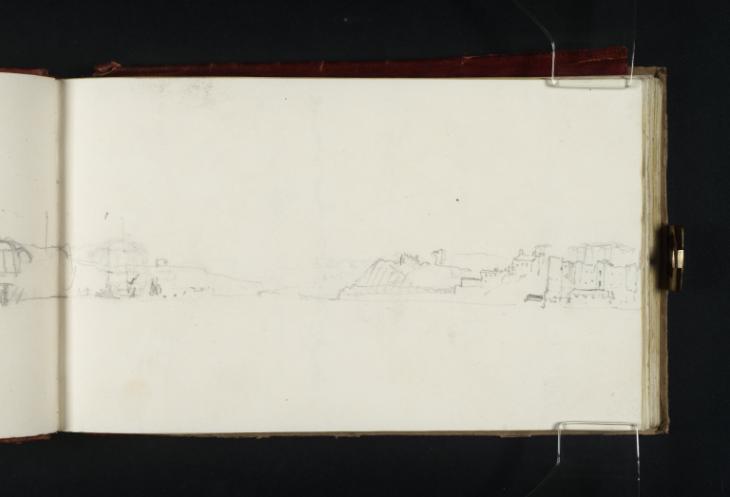Joseph Mallord William Turner The River Medway at Upnor Castle c.1821
Image 1 of 2
Joseph Mallord William Turner,
The River Medway at Upnor Castle
c.1821
Joseph Mallord William Turner 1775–1851
Folio 87 Verso:
The River Medway at Upnor Castle c.1821
D17501
Turner Bequest CXCIX 87a
Turner Bequest CXCIX 87a
Pencil on white wove paper, 112 x 190 mm
Partial watermark ‘nard | 20’
Partial watermark ‘nard | 20’
Accepted by the nation as part of the Turner Bequest 1856
References
1909
A.J. Finberg, A Complete Inventory of the Drawings of the Turner Bequest, London 1909, vol.I, p.609, CXCIX 87 a, as ‘The Medway at Castle Upnor’.
1974
Martin Butlin, Andrew Wilton and John Gage, Turner 1775–1851, exhibition catalogue, Royal Academy, London 1974, p.122 under no.425.
1979
Andrew Wilton, J.M.W. Turner: His Life and Work, Fribourg 1979, p.399 under no.847.
1984
Craig Hartley, Turner Watercolours in the Whitworth Art Gallery, exhibition catalogue, Whitworth Art Gallery, Manchester 1984, p.49 under no.39.
1989
Ann Sumner, Ruskin and the English Watercolour: From Turner to the Pre-Raphaelites, exhibition catalogue, Whitworth Art Gallery, Manchester 1989, p.50 under no.71.
1997
Charles Nugent and Melva Croal, Turner Watercolors from Manchester, exhibition catalogue, Memphis Brooks Museum of Art, Memphis 1997, p.86 under no.52.
1998
Charles Nugent, A Closer Look at Turner’s ‘Upnor Castle’, Manchester 1998, p.[2] fig.2 [detail of right centre].
As identified by Finberg, the drawing composed across folio 88 recto (D17503), the present sheet, and folio 86 verso (D17499) describes a view of the River Medway at Castle Upnor inverted relative to the foliation of the sketchbook.1 On the present page, the prospect includes the Castle at far right, the waterway at centre, and a collection of vessels at left where the study transgresses the gutter and continues on the next sheet.
This drawing is widely agreed to have informed the composition for the watercolour Upnor Castle, Kent of around 1831 (Whitworth Art Gallery)2 engraved by J.B. Allen for the England and Wales series and published in 1833 (Tate impression: T06102).3 Turner frequently returned to much earlier studies in order to produce a painting, particularly so in the case of England and Wales.4 The present sketchbook is brimming with details of maritime architecture and rigging, and a drawing on folio 43 verso (D17438) is often cited as the basis for the man of war in the finished watercolour.5 A more detailed study of the Castle is composed on folio 23 verso (D17405).6 Craig Hartley suggests that with his painting of Upnor, Turner seems interested in a depiction of ‘contemporary activity’.7 Ann Sumner argues that it is a pessimistic commentary ‘upon the decline of military might’.8 The original title of the scene as described on the engraver’s proof was ‘Castle Upnor on the Medway with part of Chatham Dock-yard and Liner’.9 Chatham appears in a great number of drawings throughout the Medway sketchbook. A comprehensive list of these instances can be found in the entry for folio 22 recto (D17402).
Upnor Castle was built in 1559 following orders from Queen Elizabeth I.10 The Queen required a fortress that would supply defence for her warships anchored in the Medway and at Chatham Dockyard.11 The letterpress which accompanied Turner’s published engraving in 1833 referenced the Dutch raid of the Medway in June 1667.12 This was the only occasion upon which Upnor Castle saw military action, and was described by the diarist John Evelyn as ‘a Dreadful Spectacle as ever any English men saw, & a dishonour never to be wiped off’.13 Nonetheless, the counter-attack on the Dutch from Upnor forced Admiral Van Ghent eventually to retreat, preventing a devastating attack on Chatham and Rochester. By the time Turner came to depict the fortress, it was being used as a powder magazine.14
In addition to the present drawing, which encompasses the three pages outlined above, further studies of Upnor Castle are to be found on folios 12 recto, 16 verso–17 recto, 23 verso, 34 recto, 47 verso–48 recto, 55 recto, and 88 recto (D17384, D17391–D17392, D17405, D17419, D17446–D17447, D17455, and D17502). Also see the River and Margate sketchbook of about 1805–9 (Tate D06405; Turner Bequest XCIX 28), and two studies for published England and Wales subjects (Tate D25246, D25276; Turner Bequest CCLXIII 124, 154).
Maud Whatley
January 2016
‘Upnor Castle’, BBC, accessed 27 January 2016, http://www.bbc.co.uk/kent/discover_kent/castles_houses/upnor.shtml .
How to cite
Maud Whatley, ‘The River Medway at Upnor Castle c.1821 by Joseph Mallord William Turner’, catalogue entry, January 2016, in David Blayney Brown (ed.), J.M.W. Turner: Sketchbooks, Drawings and Watercolours, Tate Research Publication, February 2017, https://www


